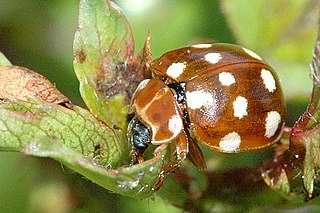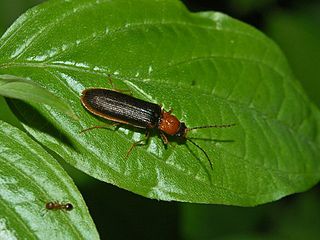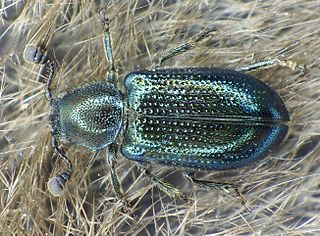| Podabrus alpinus | |
|---|---|
 | |
| Scientific classification | |
| Kingdom: | |
| Phylum: | |
| Class: | |
| Order: | |
| Suborder: | |
| Family: | |
| Genus: | |
| Species: | P. alpinus |
| Binomial name | |
| Podabrus alpinus | |
Podabrus alpinus is a species of soldier beetles native to Europe. [2] [3]
| Podabrus alpinus | |
|---|---|
 | |
| Scientific classification | |
| Kingdom: | |
| Phylum: | |
| Class: | |
| Order: | |
| Suborder: | |
| Family: | |
| Genus: | |
| Species: | P. alpinus |
| Binomial name | |
| Podabrus alpinus | |
Podabrus alpinus is a species of soldier beetles native to Europe. [2] [3]
Adults have a body length of 11 to 15 mm (0.43 to 0.59 in). Appearance varies greatly. Elytra can range from shiny black to dark brownish-gold and legs are often black or dark brown-orange with black tarsi. Typically, the pronotum has a black stripe running lengthwise with orange or pale yellow sides. It has also been found that some specimens of P. alpinus have no black marking on the pronotum. Although the appearance of the pronotum is variable, the head is consistently black from in between the compound eyes to the front of the pronotum. The antennae are mostly black with a few orange segments closer to the head. [4] [5]
P. alpinus can be found throughout Europe--excluding the Iberian Peninsula and most of the Balkans--and are most common in the Alps. [6]
P. alpinus was first described in 1798 by Swedish entomologist Gustaf von Paykull in his species publication Monographia Staphylinorum Sueciae. [7]

Oiceoptoma noveboracense is a member of the family Silphidae, or carrion beetles, which feed on decaying organic matter such as dead animals. Its common name is the margined carrion beetle, from the orange-red margins on the pronotum, which are helpful when identifying this species. The larva is typically light brown to red and also has vertical ridges on its thorax like the adult. This diurnal beetle can be found mainly in the spring into the fall, and it has a strong preference towards a deciduous forest habitat. The primary forensic importance of this beetle is its ability to use the succession of insect fauna to provide confirmation of postmortem intervals.

Adalia decempunctata, the ten-spotted ladybird or ten-spotted lady beetle, is a carnivorous beetle of the family Coccinellidae.

Calvia quatuordecimguttata, the cream-spot ladybird, is a species of ladybird in the family Coccinellidae. Its distribution is holarctic, it being found in Europe and through the East Palearctic to Japan. It is introduced to North America. This ladybird is generally 4 to 5 millimetres in length and varies in appearance depending on the geographical location. It usually lives in hedgerows and deciduous trees.

Chrysomela populi is a species of broad-shouldered leaf beetle belonging to the family Chrysomelidae, subfamily Chrysomelinae.

Cryptocephalus sericeus is a species of beetle of the family Chrysomelidae, subfamily Cryptocephalinae.

Denticollis linearis is a species of click beetle belonging to the family Elateridae subfamily Dendrometrinae.

Hycleus polymorphus is a species of Blister Beetles belonging to the family Meloidae subfamily Meloinae.

Cantharis obscura is a species of beetle belonging to the family Cantharidae

Smaragdina affinis is a species of short-horned leaf beetles belonging to the family Chrysomelidae, subfamily Clytrinae.
Philorhizus sigma is a species of brown coloured ground beetle in the Lebiinae subfamily that can be found in everywhere in Europe, except for Andorra, Croatia, Monaco, San Marino, Vatican City and European islands. It is also found in such Asian countries as Georgia and Israel.

Apoderus coryli, common name hazel-leaf roller weevil, is a species of leaf-rolling beetles belonging to the family Attelabidae subfamily Attelabinae. Because of the trunk-like elongated head, it is often mistakenly attributed to the weevils.

Necrobia violacea is a species of beetle in family Cleridae. Cleridae beetles are a predaceous beetle found within forest and woodland environments, and can be associated with stored food products as both pests and predators of other insects.

Stilbus testaceus is a species of beetles commonly called the shining flower beetles belonging to the family Phalacridae.

Sphaeroderma testaceum, the artichoke beetle, is a species of flea beetles in the family Chrysomelidae.

Bodiloides ictericus is a species of dung beetle in the family Scarabaeidae, found in the Palearctic. It is one of more than 50 species in the genus Bodiloides.
Melasis fermini is a rare species of soldier beetles native to a small area of Spain. It has only been found in three locations in Guadalajara, Caceres, and Ciudad Real, and its estimated range is less than twelve square kilometers. The species was named in honor of the late Fermín Martín Piera, a Spanish biologist and taxonomist who specialized in the study of dung beetles.

Henosepilachna argus, common name bryony ladybird, is a species of beetle in the family Coccinellidae.
Podabrus alexanderi is a species of soldier beetle in the family Cantharidae. It is found in North America.

Lygistopterus sanguineus is a species of net-winged beetle in the family Lycidae.